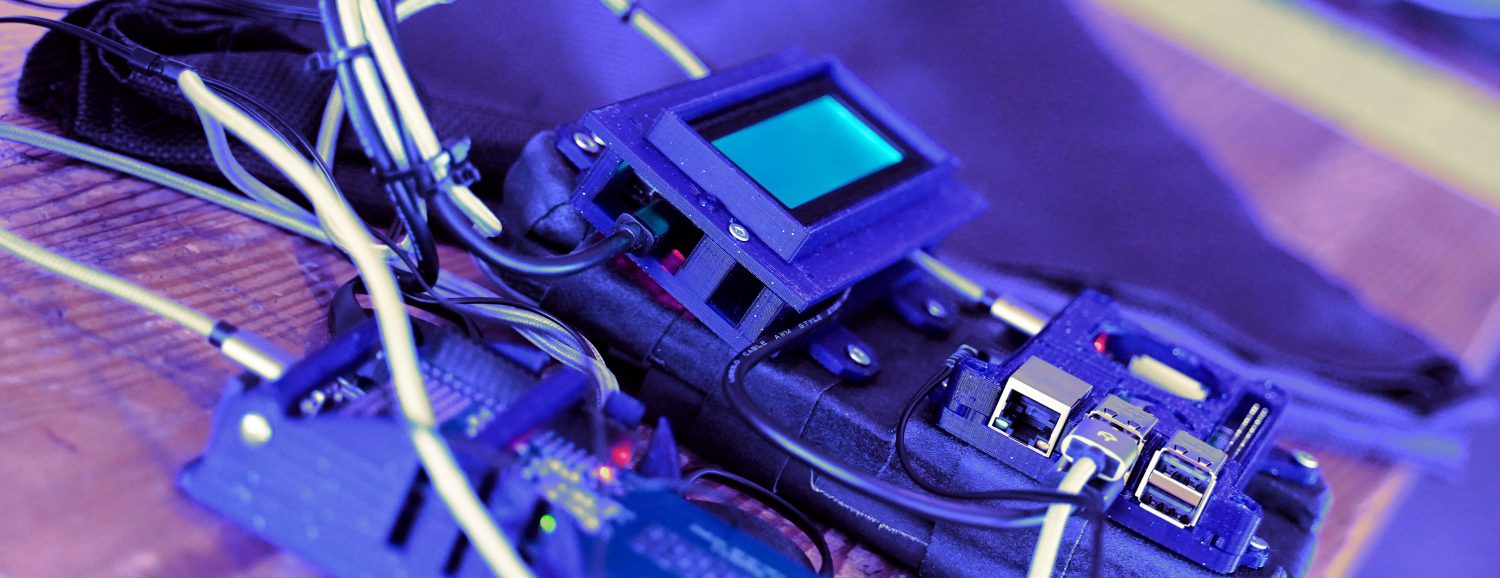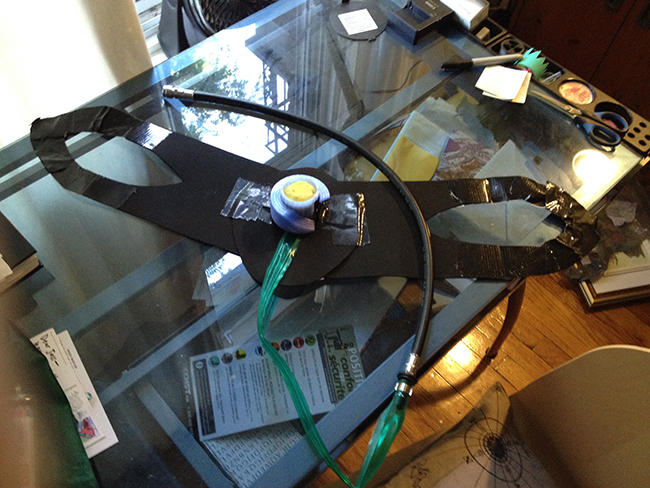This September, I’ve officially started my PhD, and with it, a pretty amazing directed reading course with my supervisor, Dr. Rilla Khaled, entitled “Critical Making and Design”. Since we’re keeners, we started a little earlier than the class start date, and I’ve already had the chance to do a bit of design work and am learning a lot. With that in mind, I’ve decided to start this series of blog posts talking about the design process and the objects themselves.
The first object is called the DELFINOX and it is a filter system for dolphins to help them in their “double-bind” between ocean acidification and pollution and air pollution. Here is a PDF document that is meant to accompany the object.
This is the object itself. It’s made of mostly recyclable, reusable or reused materials, with the exception of some duct tape and a few materials that I’m unsure about. The blue plastic is PLA, or polylactic acid plastic. The green tubing is recyclable plastic, possibly originally intended for aquarium use. The black rubber hose is borrowed from a small stash of extra scuba diving equipment that my household has around. There’s also crafting foam used to approximate neoprene and part of a household sponge for the filtration system.
The instructions for this object were fairly free-form – in a nutshell, they were to make a thing and see what happens. Dolphins were not my first thought.
At first, I discussed what I had to do at length with just about everyone who I happened to be spending time with – friends, family, other researchers. I was excited – this was my first official PhD assignment after all – and my first formal design object.
So far, the critical design examples (and I’m using that term very broadly, thinking of design as a spectrum where designs can be critical or affirmative of existing norms and practices to varying degrees) that I’ve been reading about are, at their core, about anxieties or fears. Many deal with the fear of death in some form, whether it be Dunne and Raby’s huggable plush mushroom clouds (from Designs For Fragile Personalities in Anxious Times, 2004/05), or the Prayer Companion (an object that I find a bit questionable, both in terms of taste and the tone in which the project is framed).
At first, in searching for my design inspiration, I thought a lot about waiting. I thought about what I do when I’m waiting, how waiting alters my perception of time, how maybe waiting could be a good thing – which led me to the converse. What happens when waiting is a really bad thing? What happens when we wait too long?
I’ve been a scuba diver for eight years now, and a human being on the planet earth for, oh, just a little bit longer than that. I think about water a lot – and that means I think about climate change and their impact on the water, too. It is something that makes me anxious, because it often feels like I have very little direct control over it. And, although I am hopeful, so far, we have been surprisingly short-sighted and stubborn as a species when it comes to our approaches for dealing with climate change.
Now, I know this is a bit silly, but after thinking about the project for a few days, the idea for DELFINOX came to me in my sleep. In the morning, I joked with Tom (my husband) about it a bit, as I imagined this object: “What are we going to do, fit aquarium filters onto all the dolphins? Well…maybe.”
Despite knowing that the object would not in fact have to work, and would probably never be within 100 kilometres of a dolphin, it was nevertheless important to me that my approach was possible, if improbable. I studied dolphin physiology – specifically, how dolphins breathe and how blowholes work, and I thought about how my scuba diving equipment operates. I wanted to design something that, in theory, wouldn’t need an air tank (even rebreathers need a small cylinder). However, most dolphins surface fairly often for air (about every 15 minutes or so), so it wasn’t necessary that there be a whole lot of air in the system, just that it could filter through the system sufficiently to be scrubbed before the dolphin needed it, or enough for there to be an emergency supply. So, I added a longish tube that would rest against the dolphin’s body.
In terms of powering the device, dolphins swim fast and can expel air fairly strongly through their blowholes. It made sense to me to use the motion of the dolphin to power the device, sort of like the way that the motion of the water is used in hydroelectricity, or, that classic comic idea of a hamster running in a wheel.
My choices when it came to crafting the physical object were based on three goals: trying to reuse objects that I already had on-hand (such as previously printed items from my 3D-printing recycling box, or the borrowed scuba hose), trying to remind the viewer of an aquarium filter, and trying to make choices that would be comfortable, unlikely to be torn off, and practical long-term for a dolphin.
In a way, this object, although the notion of fitting each and every dolphin with one may seem impossible, is about taking back control over something that seems so far beyond my control. Feeling a personal responsibility for climate change as one of billions of people is an uncomfortable feeling. This object imagines a future or even a present where human beings do feel responsible for each and every dolphin, for example, and take personal responsibility for them. It is too easy to lament about climate change and say that there is nothing to be done. Collective actions start with individual ones, I guess.
A SMALL SIDEBAR: Because this came up when I was talking about the project a few times, I thought I’d share this somewhat gruesome story that I had in mind while working on this project. Dolphins have a particular history here in Montreal: for Expo ’67, the city acquired dolphins, which were hosted in the Montreal Aquarium (also known as the Alcan Aquarium, a company my father used to work for). After Expo, people sort of forgot about the aquarium, and in 1980, there was a blue-collar workers’ strike. The six workers who were responsible for feeding the dolphins refused to do so, and three of the six dolphins starved over a course of months. Their trainers tried to save them at the end, but they waited too long.
You can watch footage of their arrival to Montreal here.
Here are two newspaper article detailing the event at the time:
The Evening Independent


One thought on “Critical Making and Design: Thinking about DELFINOX”
Comments are closed.